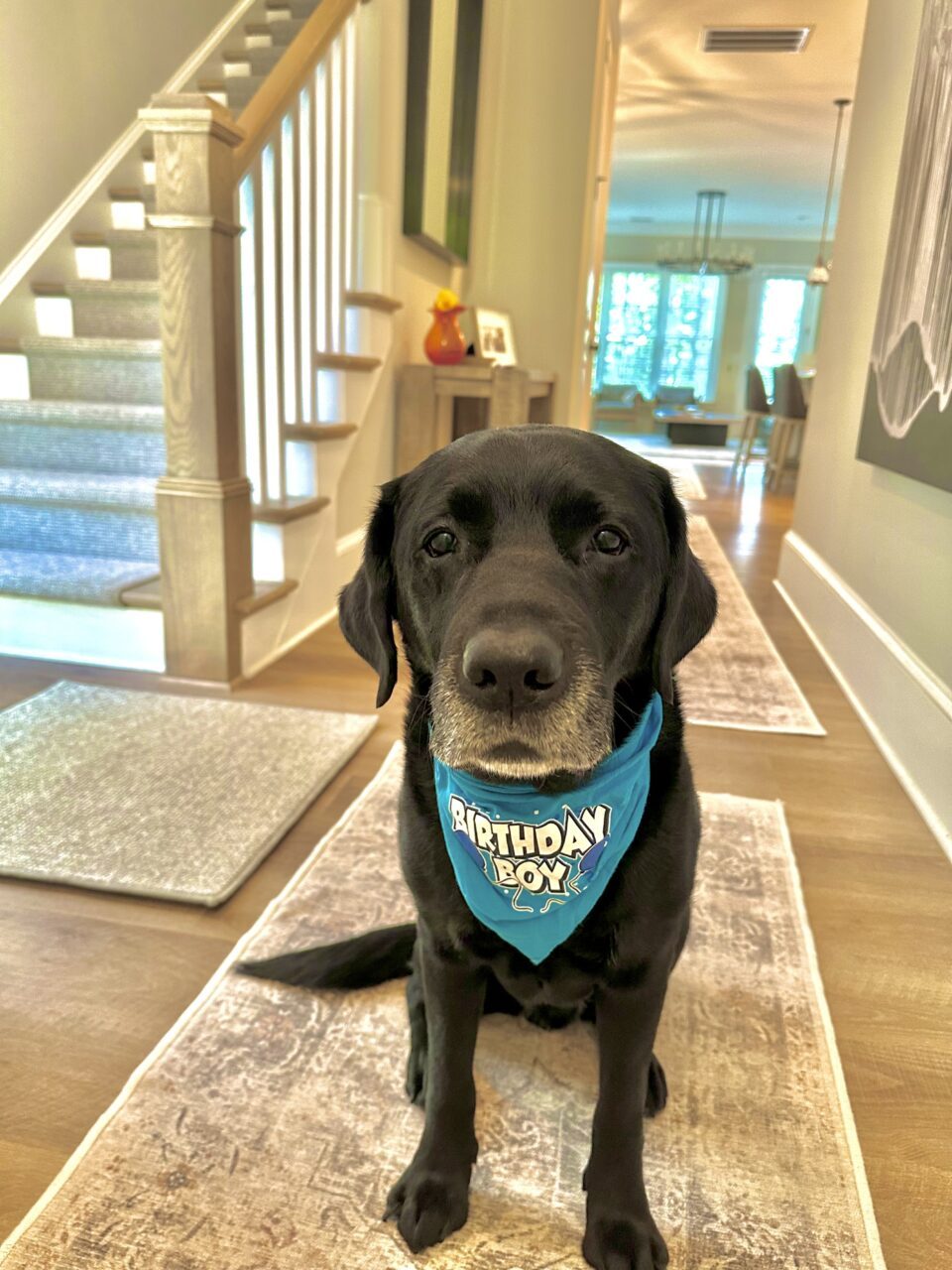By Dr. Kristin Shaw
My passion for osteoarthritis and chronic pain management stems from having been a mom to 3 dogs with arthritis and chronic pain. Bella, Bailey and Beans (Yellow Lab, Pit X and Frenchie) taught me more than any textbook, residency or training course ever could about the challenges and heart aches that come with trying to keep your beloved friend comfortable. In particular, I learned that if you wait too long to identify and treat pain, it becomes extremely hard to control, and ultimately you are left making the hardest but most compassionate decision possible to end pain once and for all. That was over 10 years ago and I have spent the last decade dedicated to learning and teaching about how to identify arthritis and chronic pain, ways we can reduce the progression of arthritis, methods to control pain, and how to improve the quality of life for dogs with arthritis and their caregivers.
My handsome and perfect boy Arrow (Black Lab) turned 9 in July 2024 and he does not have joint disease. There is absolutely still the chance that he will injure himself or rupture an ACL, so I know we are not out of the woods. But I have been very proactive about looking for evidence of developmental joint disease and controlling all of the things I can control that may impact his joint health. I will share with you what I have done with my own dog to reduce the chances of arthritis, but I cant tell you exactly what to do for your dog. There is no one-size-fits all approach to arthritis prevention or management and you should work with your veterinarian to develop a plan for your pooch.
My pro-active approach for Arrow:
- Looking for hip dysplasia early: When he was 16 weeks old I brought Arrow into my practice, sedated him, and tested his hips for an “Ortolani sign.” This is a test for hip dysplasia and it can be done as early as 16 weeks of age. If it is “positive,” this means there is hip dysplasia (ie the hips are lose) and this predisposes to hip arthritis. There is a minor surgical procedure call JPS that can be performed in puppies to reduce the looseness in the hips and reduce the chance of hip arthritis. Importantly, there is a narrow window of time that JPS can be performed- ideally between 14-18 weeks of age. Arrow had a negative Ortolani, meaning he does not have hip dysplasia. However, had he had a positive sign, I would have taken him to surgery that day. It has been a great piece of mind knowing that Arrow does not have hip dysplasia. Please note: dogs do not “get” hip dysplasia as they age. It is a condition that develops in the first months of life and can become progressive, leading to hip arthritis, which does get worse with age.
- Maintaining a lean body condition: For the first month or so that I had Arrow he was an adorable roly-poly, chunky Lab puppy. But I knew that the most important thing I could do to reduce the chances of joint disease and arthritis was to keep Arrow on the lean side of normal by not over-feeding him. I will admit, this is really hard to do in a growing puppy (especially a Lab!) while you are also training them using treats. I fed Arrow a high quality commercial dog food formulated for large breed puppies. I adjusted his food based on his body condition, and this almost always meant feeding less than the bag recommended. We used a portion of his food as training treats and a few other low-calorie training treats. Once he was full grown, we switched to a commercial fresh cooked diet that was formulated by a veterinary nutritionist for about 75% of his meals, and kibble for the remainder. He does get treats (including human food- blueberries, watermelon, apples, carrots) and Kongs frozen with pumpkin for enrichment and to help keep him feeling full, but these don’t make up any more than 10% of his daily calories. Arrow has a nice waistline when viewed from the top and the side– this is not common for English Labs and I am often asked what breed he is!
- Appropriate exercise: When Arrow was a puppy, we worked on leash training and basic obedience skills and he played in the yard with Beans. I did not take him for purposeful runs and minimized opportunities for him to jump down or slip and slide. He got to play with other friends when he came to work with me and he learned to walk in the underwater treadmill at a young age. (This backfired because he learned that when in water his feet should touch, so he is the only Lab I know that doesn’t swim!). We started doing additional exercises working on body awareness, such as walking backwards and walking across uneven surfaces. Admittedly, I was very lucky that Arrow got to grow up in a veterinary rehab clinic. Now that the practice I work in does not have a rehabilitation gym, Arrow continues to go for daily walks and we work his therapeutic exercises into our daily routine. The keys to exercise are to make it a regular part of your dog’s lifestyle by going for daily walks, ideally incorporating therapeutic exercises aimed at body awareness and muscle strengthening, and avoiding high impact activity (jumping down, aggressive fetching or ball play).
- RUGS!: Our house is covered in rugs. When we moved to a new house and there were beautiful hardwood floors and a beautiful wood staircase, I immediately covered them in rugs. Slippery floors + zoomies = recipe for injury and sore joints. Even now that Arrow is less prone to zoomies (though he will chase his younger brother around the house), it is clear that he prefers to walk on the carpeted areas versus anywhere that is exposed. Importantly, there is a rug at the base of the stairs and outside of his kennel so he has traction when he is getting up. I truly believe that rugs are the unsung hero of arthritis management.
- Delayed neutering: OK, this topic can be controversial. But there is evidence that shows that spaying and neutering dogs increases the risk of joint disorders such as hip dysplasia and CCL tears (though it is breed dependent). I waited until Arrow was 2 years old to neuter him. Guidelines came out recently (after Arrow was neutered) that suggest male Labradors should not be neutered before 6 months of age. Check out this article to read more.
Arrow does not receive any joint supplements. At 9 years old he is strong, healthy and active. I will never know the true influence of the things listed above on his joint health, but I will continue to do my best to practice what I preach and I will monitor Arrow extremely closely for signs of pain. He has needed a few days of pain relievers after rough housing with his brother (he pulled a muscle in his hip), and if he ever does have signs of chronic pain, I plan to be very proactive in controlling that pain to reduce the development of maladaptive pain. And if he tears his cruciate, he will be heading to surgery ASAP for a TPLO. Finally, I expect to have many, many more years with Arrow during which I know he will continue to teach me and humble me. And I will continue share what I learn with other caregivers.
Reviewed/Updated 12/2024

